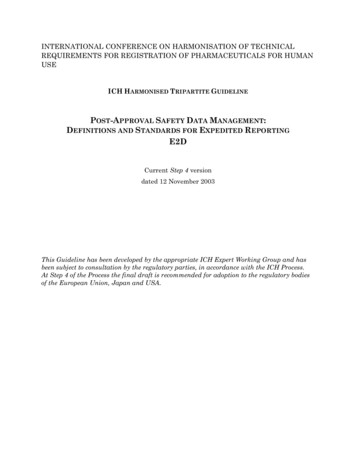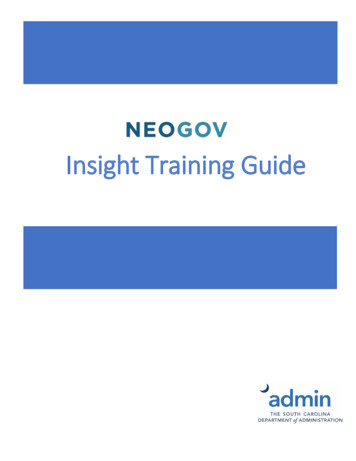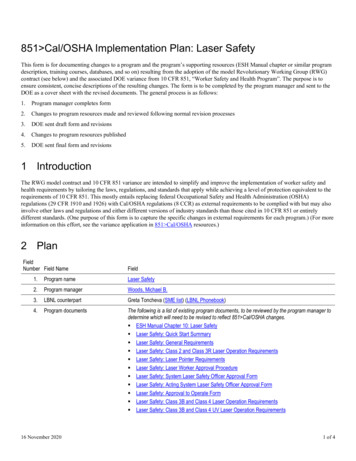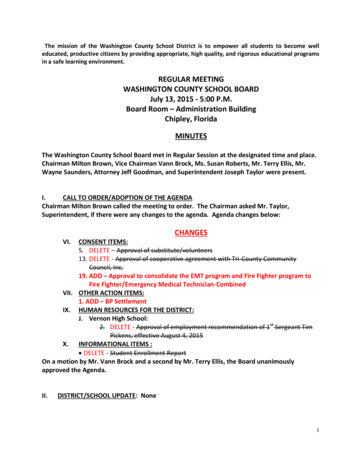
Transcription
INTERNATIONAL CONFERENCE ON HARMONISATION OF TECHNICALREQUIREMENTS FOR REGISTRATION OF PHARMACEUTICALS FOR HUMANUSEICH HARMONISED TRIPARTITE GUIDELINEPOST-APPROVAL SAFETY DATA MANAGEMENT:DEFINITIONS AND STANDARDS FOR EXPEDITED REPORTINGE2DCurrent Step 4 versiondated 12 November 2003This Guideline has been developed by the appropriate ICH Expert Working Group and hasbeen subject to consultation by the regulatory parties, in accordance with the ICH Process.At Step 4 of the Process the final draft is recommended for adoption to the regulatory bodiesof the European Union, Japan and USA.
E2DDocument HistoryFirstHistoryCodificationE2DApproval by the Steering Committee under Step 2 andrelease for public uly2003Current Step 4 versionE2DApproval by the Steering Committee under Step 4 andrecommendation for adoption to the three ICH regulatorybodies.12November2003E2D
POST-APPROVAL SAFETY DATA MANAGEMENT:DEFINITIONS AND STANDARDS FOR EXPEDITED REPORTINGICH Harmonised Tripartite GuidelineHaving reached Step 4 of the ICH Process at the ICH Steering Committee meetingon 12 November 2003, this guideline is recommended foradoption to the three regulatory parties to ICHTABLE OF CONTENTS1.INTRODUCTION. 12.DEFINITIONS AND TERMINOLOGY ASSOCIATEDWITH POST-APPROVAL DRUG SAFETY EXPERIENCE. 12.1Adverse Event (AE). 12.2Adverse Drug Reaction (ADR). 12.3Serious AE/ADR . 12.4Unexpected ADR . 22.5Healthcare Professional. 22.6Consumer. 23.SOURCES Of INDIVIDUAL CASE SAFETY REPORTS . 33.1Unsolicited Sources . 33.1.1Spontaneous Reports . 33.1.2Literature . 33.1.3Internet . 33.1.4Other Sources. 43.2Solicited Sources . 43.3Contractual Agreements. 43.4Regulatory Authority Sources . 44.STANDARDS FOR EXPEDITED REPORTING . 54.1What Should Be Reported?. 54.1.1Serious ADRs . 54.1.2Other Observations . 54.1.2.1Lack of Efficacy. 5i
Post-Approval Safety Data Management: Definitions and Standards for Expedited Reporting4.1.2.2Overdose . 54.2Minimum Criteria for Reporting . 54.3Reporting Time Frames . 64.4Non-serious ADRs . 65.GOOD CASE MANAGEMENT PRACTICES . 65.1Assessing Patient and Reporter Identifiability1 . 65.2The Role of Narratives . 75.3Clinical Case Evaluation . 75.4Follow-up Information . 75.4.15.5Pregnancy Exposure . 8How to Report. 8REFERENCES . 9ATTACHMENT. 10ii
POST-APPROVAL SAFETY DATA MANAGEMENT:DEFINITIONS AND STANDARDS FOR EXPEDITED REPORTING1.INTRODUCTIONIt is important to establish an internationally standardized procedure in order toimprove the quality of post-approval safety information and to harmonise the way ofgathering and reporting information. The ICH E2A guideline provides guidance onpre-approval safety data management. Although many stakeholders have appliedICH E2A concepts to the post-approval phase, there is a need to provide furtherguidance on definitions and standards for post-approval expedited reporting, as wellas good case management practices. This guideline is based on the content of ICHE2A guideline, with consideration as to how the terms and definitions can be appliedin the post-approval phase of the product life cycle.2.DEFINITIONS AND TERMINOLOGY ASSOCIATED WITH POSTAPPROVAL DRUG SAFETY EXPERIENCE2.1Adverse Event (AE)An adverse event is any untoward medical occurrence in a patient administered amedicinal product and which does not necessarily have to have a causal relationshipwith this treatment. An adverse event can therefore be any unfavorable andunintended sign (for example, an abnormal laboratory finding), symptom, or diseasetemporally associated with the use of a medicinal product, whether or not consideredrelated to this medicinal product.2.2Adverse Drug Reaction (ADR)Adverse drug reactions, as established by regional regulations, guidance, andpractices, concern noxious and unintended responses to a medicinal product.The phrase “responses to a medicinal product” means that a causal relationshipbetween a medicinal product and an adverse event is at least a reasonable possibility(refer to the ICH E2A guideline).A reaction, in contrast to an event, is characterized by the fact that a causalrelationship between the drug and the occurrence is suspected. For regulatoryreporting purposes, if an event is spontaneously reported, even if the relationship isunknown or unstated, it meets the definition of an adverse drug reaction.2.3Serious AE/ADRIn accordance with the ICH E2A guideline, a serious adverse event or reaction is anyuntoward medical occurrence that at any dose:*results in death,*is life-threatening(NOTE: The term “life-threatening” in the definition of “serious” refers to anevent/reaction in which the patient was at risk of death at the time of theevent/reaction; it does not refer to an event/ reaction which hypotheticallymight have caused death if it were more severe),*requires inpatient hospitalisation or results in prolongation of existinghospitalisation,*results in persistent or significant disability/incapacity,1
Post-Approval Safety Data Management: Definitions and Standards for Expedited Reporting*is a congenital anomaly/birth defect,*is a medically important event or reaction.Medical and scientific judgment should be exercised in deciding whether othersituations should be considered serious such as important medical events thatmight not be immediately life-threatening or result in death or hospitalisationbut might jeopardise the patient or might require intervention to prevent oneof the other outcomes listed in the definition above. Examples of such eventsare intensive treatment in an emergency room or at home for allergicbronchospasm, blood dyscrasias or convulsions that do not result inhospitalization, or development of drug dependency or drug abuse.2.4Unexpected ADRAn ADR whose nature, severity, specificity, or outcome is not consistent with the termor description used in the local/regional product labeling (e.g. Package Insert orSummary of Product Characteristics) should be considered unexpected. When aMarketing Authorisation Holder (MAH) is uncertain whether an ADR is expected orunexpected, the ADR should be treated as unexpected.An expected ADR with a fatal outcome should be considered unexpected unless thelocal/regional product labeling specifically states that the ADR might be associatedwith a fatal outcome.“Class ADRs” should not automatically be considered to be expected for the subjectdrug. “Class ADRs” should be considered expected only if described as specificallyoccurring with the product in the local/regional product labeling. This is illustrated inthe following examples: “As with other drugs of this class, the following undesirable effect occurs withDrug X.” “Drugs of this class, including Drug X, can cause.”If the ADR has not been documented with Drug X, statements such as the followingare likely to appear in the local/regional product labeling: “Other drugs of this class are reported to cause ” “Drugs of this class are reported to cause., but no reports have been receivedto date with Drug X.”In these situations, the ADR should not be considered as expected for Drug X.NOTE: The term “listedness” is not applicable to expedited reporting but should beused to characterize the ADR according to the Company Core Safety Information(refer to ICH E2C guideline for definitions).2.5Healthcare ProfessionalHealthcare professional is defined as a medically-qualified person such as a physician,dentist, pharmacist, nurse, coroner, or as otherwise specified by local regulations.2.6ConsumerConsumer is defined as a person who is not a healthcare professional such as apatient, lawyer, friend, or relative of a patient.2
Post-Approval Safety Data Management: Definitions and Standards for Expedited Reporting3.SOURCES Of INDIVIDUAL CASE SAFETY REPORTS3.1Unsolicited Sources3.1.1 Spontaneous ReportsA spontaneous report is an unsolicited communication by a healthcare professional orconsumer to a company, regulatory authority or other organization (e.g. WHO,Regional Center, Poison Control Center) that describes one or more adverse drugreactions in a patient who was given one or more medicinal products and that doesnot derive from a study or any organized data collection scheme.Stimulated reporting can occur in certain situations, such as notification by a “DearHealthcare Professional” letter, publication in the press, or questioning of healthcareprofessionals by company representatives. These reports should be consideredspontaneous.Consumer adverse reaction reports should be handled as spontaneous reportsirrespective of any subsequent “medical confirmation”. Regulatory Authorities mightrequire medical confirmation for the purpose of expedited reporting. Emphasis shouldbe placed on the quality of the report and not on its source. Even if reports receivedfrom consumers do not qualify for regulatory reporting, the cases should be retained.3.1.2 LiteratureEach MAH is expected to regularly screen the worldwide scientific literature byaccessing widely used systematic literature reviews or reference databases. Thefrequency of the literature searches should be according to local requirements or atleast every two weeks. Cases of ADRs from the scientific and medical literature,including relevant published abstracts from meetings and draft manuscripts, mightqualify for expedited reporting. A regulatory reporting form with relevant medicalinformation should be provided for each identifiable patient. The publicationreference(s) should be given as the report source; additionally a copy of the articlemight be requested by the local regulatory authority to accompany the report. Allcompany offices are encouraged to be aware of publications in their local journals andto bring them to the attention of the company safety department as appropriate.The regulatory reporting time clock starts as soon as the MAH has knowledge thatthe case meets minimum criteria for reportability.If the product source, brand, or trade name is not specified, the MAH should assumethat it was its product, although the report should indicate that the specific brandwas not identified.If multiple products are mentioned in the article, a report should be submitted only bythe applicant whose product is suspected. The suspect product is that identified assuch by the article's author.3.1.3 InternetMAHs should regularly screen websites under their management or responsibility forpotential ADR case reports. MAHs are not expected to screen external websites forADR information. However, if an MAH becomes aware of an adverse reaction on awebsite that it does not manage, the MAH should review the case and determinewhether it should be reported.3
Post-Approval Safety Data Management: Definitions and Standards for Expedited ReportingMAHs should consider utilising their websites to facilitate ADR data collection, e.g.,by providing ADR forms for reporting or by providing appropriate contact details fordirect communication.Unsolicited cases from the Internet should be handled as spontaneous reports. For thedetermination of reportability, the same criteria should be applied as for casesprovided via other ways.In relation to such cases from the Internet e.g. e-mail, identifiability of the reporterrefers to the existence of a real person, i.e., it is possible to verify that the patient andthe reporter exist.3.1.4 Other SourcesIf an MAH becomes aware of a case report from non-medical sources, e.g. the lay pressor other media, it should be handled as a spontaneous report. For the determinationof reportability, the same criteria should be applied as for other reports.3.2Solicited SourcesSolicited reports are those derived from organized data collection systems, whichinclude clinical trials, registries, post-approval named patient use programs, otherpatient support and disease management programs, surveys of patients or healthcareproviders, or information gathering on efficacy or patient compliance. Adverse eventreports obtained from any of these should not be considered spontaneous.For the purposes of safety reporting, solicited reports should be classified as studyreports, and therefore should have an appropriate causality assessment by ahealthcare professional or an MAH. Further guidance on study-related issues, suchas managing blinded therapy cases, can be found in the ICH E2A guideline.3.3Contractual AgreementsThe marketing of many medicines increasingly takes place through contractualagreements between two or more companies, which may market same product in thesame or different countries/region. Arrangements vary considerably with respect tointer-company communication and regulatory responsibilities. Overall, this can be acomplex issue.In such relationships, it is very important that explicit licensing/contractualagreements specify the processes for exchange of safety information, includingtimelines and regulatory reporting responsibilities. Safety personnel should beinvolved in development of any agreements from the beginning. Processes should bein place to avoid duplicate reporting to the regulatory authority, e.g. assigningresponsibility to one company for literature screening.Whatever the nature of the arrangement, the MAH is ultimately responsible forregulatory reporting. Therefore, every reasonable effort should be made between thecontracting partners to minimize the data exchange period so as to promotecompliance with MAH responsibilities.3.4Regulatory Authority SourcesIndividual serious unexpected adverse drug reaction reports originating from foreignregulatory authorities are subject to expedited reporting to other authorities by eachMAH.Re-submission of serious ADR cases without new information to the4
Post-Approval Safety Data Management: Definitions and Standards for Expedited Reportingoriginating regulatory authority is not usually necessary, unless otherwise specifiedby local regulation.4.STANDARDS FOR EXPEDITED REPORTING4.1What Should Be Reported?4.1.1 Serious ADRsCases of adverse drug reactions that are both serious and unexpected are subject toexpedited reporting. The reporting of serious expected reactions in an expeditedmanner varies among countries. Non-serious adverse reactions, whether expected ornot, would normally not be subject to expedited reporting.For reports from studies and other solicited sources, all cases judged by either thereporting healthcare professional or the MAH as having a possible causal relationshipto the medicinal product would qualify as ADRs. For purposes of reporting,spontaneous reports associated with approved drugs imply a suspected causalrelationship.4.1.2 Other ObservationsIn addition to single case reports, any safety information from other observations thatcould change the risk-benefit evaluation for the product should be communicated assoon as possible to the regulatory authorities in accordance with local regulation.Examples include any significant unanticipated safety findings from an in vitro,animal, epidemiological, or clinical study that suggest a significant human risk, suchas evidence of mutagenicity, teratogenicity, carcinogenicity, or lack of efficacy with adrug used in treating a life-threatening or serious disease.4.1.2.1 Lack of EfficacyEvidence of lack of efficacy should not normally be expedited, but should be discussedin the relevant periodic safety update report. However, in certain circumstances andin some regions, individual reports of lack of efficacy are considered subject toexpedited reporting. Medicinal products used for the treatment of life-threatening orserious diseases, vaccines, and contraceptives are examples of classes of medicinalproducts where lack of efficacy should be considered for expedited reporting. Clinicaljudgment should be used in reporting, with consideration of the local product labelingand disease being treated.4.1.2.2 OverdoseReports of overdose with no associated adverse outcome should not be reported asadverse reactions. Cases associated with serious adverse reactions are consideredsubject to expedited reporting, unless otherwise specified by local regulation. Theyshould be routinely followed up to ensure that the information is as complete aspossible with regard to symptoms, treatment, and outcome. The MAH should collectany available information on overdose related to its products.4.2Minimum Criteria for ReportingIt is recommended that as much information as possible be collected at the time of theinitial report. However, for the purpose of regulatory reporting, the minimum dataelements for an ADR case are: an identifiable reporter, an identifiable patient, anadverse reaction, and a suspect product. Lack of any of these four elements means5
Post-Approval Safety Data Management: Definitions and Standards for Expedited Reportingthat the case is considered incomplete; however, MAHs are expected to exercise duediligence to collect the missing data elements.4.3Reporting Time FramesIn general, expedited reporting of serious and unexpected ADRs is required as soon aspossible, but in no case later than 15 calendar days of initial receipt of the informationby the MAH. Time frames for other types of serious reports vary among countries,depending on source, expectedness and outcome.The regulatory reporting time clock is considered to start on the date when anypersonnel of the MAH first receive a case report that fulfills minimum criteria as wellas the criteria for expedited reporting. In general, this date should be consideredday 0.When additional medically relevant information is received for a previously reportedcase, the reporting time clock is considered to begin again for submission of the followup report. In addition, a case initially classified as a non-expedited report, wouldqualify for expedited reporting upon receipt of follow-up information that indicatesthe case should be re-classified (e.g., from non serious to serious).4.4Non-serious ADRsCases of non-serious ADRs, whether expected or not, would not normally beconsidered reportable on an expedited basis. Non-serious ADRs should be included inthe periodic safety update report according to the ICH E2C guideline.5.GOOD CASE MANAGEMENT PRACTICESAccurate, complete, and bona fide information is very important for MAHs andregulatory agencies identifying and assessing ADR reports. Both are faced with thetask of acquiring sufficient information to help ensure that the reports are authentic,accurate, as complete as possible, and non-duplicative.5.1Assessing Patient and Reporter Identifiability1Patient and reporter identifiability is important to avoid case duplication, detectfraud, and facilitate follow-up of appropriate cases. The term identifiable in thiscontext refers to the verification of the existence of a patient and a reporter.Local data privacy laws regarding patient and reporter identifiability might apply.One or more of the following should automatically qualify a patient as identifiable:age (or age category, e.g., adolescent, adult, elderly), gender, initials, date of birth,name, or patient identification number. In addition, in the event of second-handreports, every reasonable effort should be made to verify the existence of anidentifiable patient and reporter.All parties supplying case information or approached for case information should beidentifiable: not only the initial reporter (the initial contact for the case), but alsoothers supplying information.In the absence of qualifying descriptors, a report referring to a definite number ofpatients should not be regarded as a case until the minimum four criteria for casereporting are met. For example, “Two patients experienced ” or “ a few patientsexperienced” should be followed up for patient-identifiable information beforeregulatory reporting.6
Post-Approval Safety Data Management: Definitions and Standards for Expedited Reporting5.2The Role of NarrativesThe objective of the narrative is to summarize all relevant clinical and relatedinformation, including patient characteristics, therapy details, medical history,clinical course of the event(s), diagnosis, and ADR(s) including the outcome,laboratory evidence (including normal ranges), and any other information thatsupports or refutes an ADR. The narrative should serve as a comprehensive, standalone “medical story”. The information should be presented in a logical time sequence;ideally this should be presented in the chronology of the patient’s experience, ratherthan in the chronology in which the information was received. In follow-up reports,new information should be clearly identified.Abbreviations and acronyms should be avoided, with the possible exception oflaboratory parameters and units. Key information from supplementary recordsshould be included in the report, and their availability should be mentioned in thenarrative and supplied on request. Any relevant autopsy or post-mortem findingsshould also be summarized in the narrative and related documents should beprovided according to local regulation and if allowed by local data privacy laws.Terms (e.g., AEs/ADRs, indication, and medical conditions) in the narrative should beaccurately reflected in appropriate data fields.5.3Clinical Case EvaluationThe purpose of careful medical review is to ensure correct interpretation of medicalinformation. Preferably, information about the case should be collected from thehealthcare professionals who are directly involved in the patient’s care. Regardless ofthe source of an ADR report, the recipient should carefully review the report for thequality and completeness of the medical information. The review should include, butis not limited to, the following considerations: Is a diagnosis possible? Have the relevant diagnostic procedures been performed? Were alternative causes of the reaction(s) considered? What additional information is needed?ADR terms should be used consistently and in accordance with recommendedstandards for diagnosis, if possible. The report should include the verbatim term asused by the reporter, or an accurate translation of it. Any company personnelreceiving reports should provide an unbiased and unfiltered report of the informationfrom the reporter. While the report recipient is encouraged to actively query thereporter to elicit the most complete account possible, inferences and imputationsshould be avoided in report submission. However, clearly identified evaluations bythe MAH are considered appropriate and are required by some regulatory authorities.When a case is reported by a consumer, his/her description of the event should beretained, although confirmatory or additional information from any relevanthealthcare professionals should also be sought and included.5.4Follow-up InformationThe information from ADR cases when first received is generally incomplete. Ideally,comprehensive information would be available on all cases, but in practice efforts7
Post-Approval Safety Data Management: Definitions and Standards for Expedited Reportingshould be made to seek additional information on selected reports, including second –hand reports (see Attachment, Recommended Key Data Elements, of this guideline).In any scheme to optimize the value of follow-up, the first consideration should beprioritization of case reports by importance. The priority for follow-up should be asfollows: cases which are 1) serious and unexpected, 2) serious and expected, and 3)non-serious and unexpected. In addition to seriousness and expectedness as criteria,cases “of special interest” also deserve extra attention as a high priority (e.g., ADRsunder active surveillance at the request of the regulators), as well as any cases thatmight lead to a labeling change decision.Follow-up information should be obtained, via a telephone call and/or site visit and/ora written request. The company should provide specific questions it would like tohave answered. Follow-up methods should be tailored towards optimizing thecollection of missing information. Written confirmation of details given verballyshould be obtained whenever possible. In exceptional circumstances, if requests forinformation have been refused by the reporter, a regulatory authority might be able toassist an MAH in obtaining follow-up data.To facilitate the capture of clinically relevant and complete information, use of atargeted questionnaire/specific form is encouraged, preferably at the time of the initialreport. Ideally, healthcare professionals with thorough pharmacovigilance trainingand therapeutic expertise should be involved in the collection and the direct follow-upof reported cases (particularly those of medical significance). For serious ADRs, it isimportant to continue follow-up and report new information until the outcome hasbeen established or the condition is stabilized. How long to follow up such cases is amatter of judgment.It is important that at the time of the original report, sufficient details about thepatient and reporter be collected and retained to enable future investigations, withinthe constraints imposed by local data privacy laws.5.4.1 Pregnancy ExposureMAHs are expected to follow up all pregnancy reports from healthcare professionalsor consumers where the embryo/foetus could have been exposed to one of its medicinalproducts. When an active substance, or one of its metabolites, has a long half-life,this should be taken into account when considering whether a foetus could have beenexposed (e.g., if medicinal products taken before the gestational period should beconsidered).5.5How to ReportThe CIOMS I form has been a widely accepted standard for expedited adverse eventreporting. However, no matter what the form or format used, it is important thatcertain basic information/data elements, when available, be included with anyexpedited report, whether in a tabular or narrative presentation. It is recommendedthat the Medical Dictionary for Regulatory Activities (MedDRA) be used for codingmedical information. The standards for electronic submission of Individual CaseSafety Reports (ICSRs), according to the ICH E2B/M2 guidelines, should beimplemented.The listing in the Attachment of this guideline addresses those data elementsregarded as desirable; if all relevant elements are not available at the time ofexpedited reporting, efforts should be made to obtain them.8
Post-Approval Safety Data Management: Definitions and Standards for Expedited ReportingREFERENCES1. Current Challenges in Pharmacovigilance: Pragmatic Approaches (Report ofCIOMS Working V), Geneva 20012. Rules Governing Medicinal Products in the European Union, Volume 9,PHARMACOVIGILANCE: Medicinal Products for Human Use, ome.htm3. Guidance for Industry: Postmarketing Safety Reporting for Human Drug andBiological Products Including Vaccines, Food and Drug Administration, March2001 (draft) http://www.fda.gov/cder/guidance/4153dft.pdf4. Safety Reporting Requireme
Post-Approval Safety Data Management: Definitions and Standards for Expedited Reporting 3 3. SOURCES Of INDIVIDUAL CASE SAFETY REPORTS 3.1 Unsolicited Sources 3.1.1 Spontaneous Reports A spontaneous report is an unsolicited communication by a healthcare professional or consumer to a company, regulatory authority or other organization (e.g. WHO,










